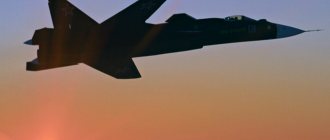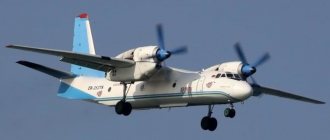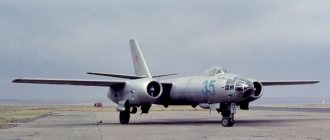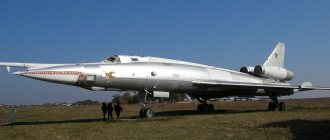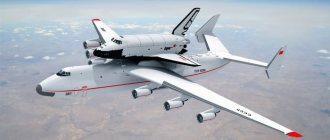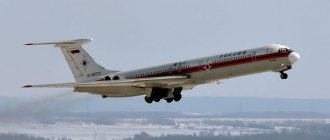Image copyright AFP Image caption On February 24, 2012, the An-148 made an emergency landing due to a wheel falling off on the left main landing gear After the crash of the Saratov Airlines An-148 near Moscow on February 11, a lot of negative feedback appeared in the Russian press and on aviation forums about this airliner: supposedly the plane had “childhood diseases”, which were only partially cured.
For example, the Vedomosti newspaper called the An-148 “one of the political projects of the period of Russian-Ukrainian friendship,” and the Dailystorm publication, citing an anonymous representative of the former operator of this airliner, said that this aircraft is far behind its competitors in terms of reliability. SSJ 100, CRJ and airliners produced by Boeing and Airbus.
The fate of the An-148, the first airliner created in the post-Soviet space after the collapse of the USSR, turned out to be truly difficult. However, many experts do not see any major shortcomings in it - the reason for its failures, in their opinion, is most likely in the conflict between Moscow and Kiev.
- The cause of the An-148 crash in the Moscow region was called a failure of speed sensors
- What is known about Saratov Airlines and claims against them
- “I flew on this ill-fated plane”: how Orsk is coping with the An-148 crash
The An-148 is considered a Ukrainian aircraft because the lead developer was the state-owned enterprise Antonov, but Russian companies also took part in the creation of the aircraft. On the An-148 page of the official website of the Antonov Group of Companies it is said that the Ukrainians created the aircraft together with 214 enterprises from 15 countries.
The aircraft was built at two enterprises - in Kyiv at a serial plant and in Russia at the Voronezh VASO, and only console parts of the wings and parts of the fuselage were supplied from Ukraine to Russia.
In response to a request from the Ukrainian BBC Service, Antonov reported that a total of 36 An-148 aircraft were manufactured, three of them are on the Ukrainian register, 29 aircraft are registered in Russia. The rest were delivered to other countries.
Image copyright AFP Image caption Saratov Airlines says they are happy with the aircraft
The curtailment of An-148 production in Russia is usually associated with a breakdown in relations with Ukraine, with both sides blaming each other for this.
VASO General Director Dmitry Prishvin said in an interview with Kommersant last year that a significant part of the problems, in his opinion, are connected with the government structures of Ukraine. In turn, the BBC Antonov stated that “the Russian side made a decision to curtail the program.”
In recent years, the Voronezh plant has supplied An-148 to the Russian Ministry of Defense. In addition to the military, these aircraft are used by the Ministry of Emergency Situations and the special flying detachment “Russia” of the Presidential Administration.
Historical reference
The creator of the new generation aircraft An 148 - ANTK named after Antonov, traces its history back to 1946, when an order of the USSR Ministry of Aviation Industry marked the creation of experimental design bureau (OKB) No. 153 in Novosibirsk, at the local aircraft plant. It was headed by O.K. Antonov, whose name the aircraft concern would later be named. In 1952, the bureau moved to Kyiv, where it is currently located. The Antonov Design Bureau (today it is called the State Enterprise (SE) Antonov) was one of the leading creators of aircraft during the Soviet era. After the collapse of the Soviet Union, it continued to operate as a Ukrainian airline. Until recent years, work on the creation of airliners of the An-148 family was carried out jointly by Ukrainian and Russian aircraft designers.
Over the years of its existence, the team of aircraft designers has developed over 100 types and modifications of aircraft:
- passenger;
- transport;
- special purpose.
In total, over 22,000 vehicles were produced. The hallmark of the Antonov team is rightfully considered to be such giant transporters as “Ruslan” and “Mriya”, which set 270 world records.
An-148 family
Airplane A 321: interior diagram
Currently, the Antonov State Enterprise cooperates with many aviation concerns (214 airlines) from 15 countries, with their participation the An-148 line of airliners was created. These are short-haul narrow-body aircraft equipped with two engines. All modifications of this model meet the requirements of modern air carriers for aircraft of this class.
In the early 90s. a prototype was created - An-74. As a result of the design work carried out, it became a passenger-and-freight vehicle, but was not very convenient for transporting people. Therefore, work on the project continued, and as a result, a new model appeared - the An-74-68. In 2002, the project was already ready, and preparations began for the production of a prototype, which was produced in 2004. In December 2004, it made its first flight under a new name - An-148, and in 2005 it was sent into serial release. The use of the airliner on commercial flights began in December 2009. Among the airlines that made a preliminary order for the supply of the An-148 airliner were:
- Aerosvit;
- Aeroflot;
- "Russia";
- "Krasnoyarsk Airlines".
When creating a line of airliners, the main model chosen was the base in the form of an aircraft of the AN 148 100 modification.
Before release from production
Today there are already 11 modifications of the basic model:
- An-148-100A - a passenger airliner with 70-85 seats, with a maximum flight range of up to 2100 km;
- An-148-100B - the aircraft is designed for 70-85 people, capable of flying 3500 km;
- An-148-100E - an airliner of the same passenger capacity and capable of a flight of 4,400 km;
- An-148-100EA - an airliner, complemented by a special cabin for VIP-class passengers;
- An-148-100EM - a specialized modification used for the needs of the Ministry of Emergency Situations, equipped with a mobile hospital;
- An-148-200 – passenger airliner with a capacity of 89 people;
- An-148C is a transport and passenger aircraft equipped with a side lifting hatch;
- An-158 is an airliner with an extended fuselage for 99 passengers and a maximum flight range of 2500 km;
- An-168 is an airliner designed for a maximum flight range of up to 7000 km;
- An-168MP - specialized aircraft designed for patrolling;
- An-178 is a cargo transport aircraft created on the basis of the An-158.
Equipment
Modern navigation, flight and radio communications equipment, as well as the use of an electronic remote flight control system of an Airbus and multifunctional indicators, make it possible to use these aircraft on any air route, including on routes with a fairly high intensity of flights, day and night, both in simple and and in difficult weather conditions. The An-148-100 provides both manual and automatic aircraft navigation. The autopilot allows you to program the necessary routes, automatic landing in accordance with the standards of ICAO categories I, II and III A, horizontal and vertical navigation, takeoff and landing according to STAR and SID schemes. The equipment automatically monitors the status of all systems in flight and on the ground with subsequent provision of information to technical personnel and the aircraft crew.
Main features of the model
Embraer 190 aircraft: characteristics
The An-148 base model was equipped with two D436-148 turbofan engines located under the wings. This feature provides additional protection against foreign objects, as well as additional stabilization of the wings.
A modern navigation system, sensitive to all changes in surrounding indicators, allows you to take off and land an airliner at any airfield, even in difficult weather conditions and poor visibility.
Instrument panel in the cockpit
As for the passenger cabin, it is designed taking into account all needs and is able to provide maximum comfort during the flight. A distinctive feature is a technological solution in which the sound insulation of the interior is significantly increased.
An-148 salon
The design of the An-148 was carried out using 3D modeling methods using CALS technologies and in accordance with ISO 9000/9001-2000 standards. The use of these technologies has helped improve the following factors:
- reduction of production costs;
- facilitate the process of servicing the aircraft;
- unification of design and estimate documentation.
Also a distinctive feature of the new project was the goal of maximum versatility of the main components and modules, with the aim of using them in the development of various varieties:
- fuselage;
- power point;
- other equipment.
Currently, experts call only the Sukhoi Superjet-100 a competitor to the An-148.
Aviation experts promised the airliner excellent prospects for the future and stable demand. Thus, in 2010, the manufacturer received about 200 applications for the An-148. Currently, An-148 aircraft are produced at aircraft factories in Kharkov and Voronezh.
The crash of a passenger An-148 in the Moscow region. What is known about the tragedy
5154
Serious incidents have also occurred with aircraft of this type before. In 2020, one of the engines of RA-61706 failed while climbing, the plane made an emergency landing in Saratov, and one of the engines of RA-61711 caught fire while climbing, the plane returned to the departure airport (Talakan).
So, in 2010, RA-61701 began to dive sharply with a strong list to starboard due to a short circuit in the fly-by-wire control system. In 2012, his landing gear wheel fell off during takeoff.
Technical characteristics of An-148
The ATR 72 aircraft and its main characteristics
To describe the main technical parameters of the An-148 modification, the following characteristics can be given:
- length – 29.13 m;
- height – 8.19 m;
- dead weight – 22.5 tons;
- maximum take-off weight – from 38.55 to 43.70 tons;
- load capacity – from 9.68 to 10.10 tons;
- wingspan - 28.91 m;
- wing area – 87.32 m2;
- cruising speed – 840 km/h;
- maximum speed – 875 km/h;
- maximum flight altitude – 12400 m;
- maximum flight range - in the range of 1570-7000 km;
- fuel consumption – from 1550 to 1650 kg per hour;
- seats for passengers – 45-99 (depending on modification);
- The airliner's crew is 2 people.
It should be noted that all modifications are designed for operation at temperatures from -55 to +45 degrees Celsius, with a service life of at least 30 years. For maintenance (reception and departure of the aircraft), a runway with a length of 1560 to 1885 m is required (depending on the modification of the aircraft).
The maximum possible number of flights according to the specification is from 30 to 60 thousand hours, and the maximum number of flight hours is 80,000.
As for security measures on board, taking into account modern realities associated with terrorist attacks and attempts to hijack an aircraft, the developers have provided the following:
- armored bulletproof bulkheads and doors in the cockpit;
- a special compartment for weapons in the cockpit;
- radio, - and video communication system with the flight attendant compartment;
- the passenger compartment is equipped with a video surveillance system;
- special compartment for isolating suspicious items.
Passenger cabin
Depending on the modification, the capacity of passenger compartments varies from 45 to 99 passengers. Currently, airliners are being produced in which the cabin is divided into business and economy class. The business lounge has either 8 or 10 seats. The cabin has 2 rows of seats, 2 seats on each side.
Business class cabin
Important! In terms of seat comfort, all seats in business class are comfortable, the only difference is that the 4 seats in the first row have the most legroom.
The economy class cabin has a less wide aisle between the rows, because... passenger seats are placed according to a 2-3 pattern - on the left side there are 2 seats in a row, on the right side - 3 seats each. Passenger seats meet the requirements of international standards for comfort and safety for passengers.
An 148: aircraft diagram
Just like in business class, the most comfortable seats for passengers will be the seats in the first row, which have more legroom.
Additional Information. In the first rows, passengers can get up and walk around the cabin without disturbing their neighbors - the wide space up to the bulkhead allows them to move freely.
At the same time, the least successful places in this case will be the places on the edge, next to the passage, due to the fact that the passage is quite narrow. But the worst seats in the cabin are considered to be the seats in the last row, because... they are located next to the toilet, and there will always be passengers walking here. Also at this end there is a buffet and staff areas. It is worth purchasing tickets for these seats only as a last resort, when others are already occupied.
Economy class passenger seats
Otherwise, your stay in the passenger cabin of the airliner will be comfortable. Large luggage compartments are equipped for hand luggage - 4.2 m³, this is a record figure for short-haul airliners.
In accordance with modern requirements, equipment is installed on board that allows passengers to use mobile phones and the Internet during the flight. Also, if necessary, an entertainment system is installed in the cabin, which includes the ability to watch movies and listen to music.
The aircraft is equipped with a fairly large luggage compartment, allowing for the transportation of up to 14.6 m³ of cargo.
Interior layout and best seats
There are two layouts of the An-148 cabin: one- and two-class. Both versions of the airliner are effectively used by Airlines.
With a single-class layout, the cabin can accommodate the following number of seats for passengers:
- 75;
- 80;
- 85 seats.
In the cabin for transporting 75 passengers, the distance between the rows of seats is 81 cm. The aircraft also has 2 toilets and 2 kitchen areas. With this arrangement, the best seats are considered to be those located in the first row. The distance between the seats allows you to unfold the seat back without disturbing your neighbor.
In the cabin, for the carriage of 80 passengers, the seats are spaced at intervals of 76 cm. As in the previous layout, the aircraft has 2 sanitary rooms and 2 kitchen compartments.
Salon in An-148
In the cabin, which has 85 passenger seats, the distance between their rows is 76 cm. The increase in the number of seats was due to the modernization of the cabin. The designers left 1 sanitary room and 2 kitchens on the plane.
Two-class layout of the An-148: business and economy class. The salon contains 68 seats, 2 toilets and 2 kitchen areas. The luxury compartment is located closer to the nose of the aircraft. The best seats in it are considered to be the seats in the second row. Seating arrangement: 2+2 with a central aisle. The distance between rows reaches 1 m.
In economy class, the seats are arranged in a 3+2 configuration. Between them there is a passage for serving passengers. The distance between the rows is about 75 cm. It is not possible to fully recline the seat back. The best seats in this class are in the front rows of the compartment.
Each cabin layout has special shelves for carrying hand luggage. They are located above the rows of seats. There are 2 luggage compartments under the passenger compartment.
Feature of the An-148. The aircraft can be converted into a “mobile medical hospital.” Its salon has the necessary medical equipment. The aircraft can transport up to 6 patients.
Difficulty in operation
The problem with the An-148 line of airliners is that, with a fairly small capacity compared to, for example, the Airbus A319, they are only capable of flying short distances, because on long flights (4 hours), passengers complained of discomfort and inconvenience. Attempts by the airline to improve the situation in this direction failed. Also, the carrier had to abandon the operation of the An-148 on the Moscow – St. Petersburg route, because The demand for air tickets made it possible to put more spacious airliners on the route - the same A319.
After such problems, several customers, including Aeroflot, began to refuse to purchase the An-148. Also an important role was played by a significant increase in the price of aircraft compared to the initially announced 14 million US dollars. As of today, the management of the Voronezh aircraft plant, which assembles the An-148 in Russia, will cancel the production of aircraft from 2020. What will happen to the production, which at one time was reoriented to the production of modifications of the An-148, is not yet clear, the question is under development discussions at the level of the Russian Presidential Administration.
Those aircraft that have already entered the aviation balance will be converted to meet the needs of the Ministry of Emergency Situations and transferred to their jurisdiction. However, the management of the Antonov State Enterprise and the Kharkov Aviation Plant believe that the An-148 family has a future, and the airliners have prospects for future commercial success. In the meantime, the Ukrainian president chose the An-148 as aircraft number 1.
Production and customers[ | ]
Production of the An-148 was launched at the facilities of Kyiv Aviation in Ukraine and Voronezh Aircraft Manufacturing Society (VASO) in Russia.
Russia
Construction of serial An-148 in Voronezh began under a Ukrainian license[1]. The first Voronezh-built aircraft, which received registration number RA-61701, made its first flight, lasting 41 minutes, on July 19, 2009[29]. After completing the acceptance test cycle, the aircraft was handed over to the customer on October 1, 2009. It was reported that Ilyushin Finance Co. (“IFK”) has formed a portfolio of orders for 110 An-148 aircraft of various modifications, including 56 firm contracts and 54 options. IFK also entered into a firm agreement to purchase 34 An-148 of various modifications from VASO[30].
After Aeroflot refused to purchase additional nine An-148 passenger aircraft for its subsidiary airline, only commercial aviation, as well as departments of the Ministry of Emergency Situations and the Presidential Administration [31], remained among the customers. According to the statement of VASO General Director Dmitry Prishvin to the Argumenty Nedeli newspaper, as of August 2020, the plant was negotiating with Angola and Kazakhstan about the acquisition of the An-148[32]. In addition, Dmitry Prishvin reported in September 2020 that negotiations were underway on supplies to Cuba[33]. On February 22, 2020, representatives of the Russian Ministry of Defense announced that it was planned to purchase the An-148 to replace the Tu-134[34]. On June 6, 2020, the chief of aviation of the National Guard of the Russian Federation, Lieutenant General Alexander Afinogentov, announced that “the Military-Industrial Commission of the Russian Federation has approved target figures for planning the state armaments program for 2018-2025, including on the purchase of new aircraft equipment” . It is proposed to purchase aircraft... An-148...
[35]. As of June 2020, the assembly of the last two An-148s was being completed in Voronezh, after which production was supposed to be stopped, despite the fact that the embargoed components previously supplied by Ukraine were replaced with Russian-made parts[36]. The very next day, VASO denied media reports about plans to stop production of the aircraft: “Whether the production of the An-148 will continue depends on whether there will be customers for this type of aircraft or not,” the manufacturer explained[37].
As of November 2020, the enterprise still had at least two aircraft at the final stage of readiness, awaiting the supply of Ukrainian components[38]. According to VASO's financial report for the third quarter of 2020, the program for the production and sale of An-148 aircraft will be closed. In addition, the company indicated that the production cost of the An-148 for January-September 2018 amounted to 1.4 billion rubles, exceeding the revenue from their sales by 23%[39].
Ukraine
In Ukraine, three An-148 prototypes were produced at ANTK; As part of small-scale production, Kiev Air has produced at least four An-148 aircraft[40], the last of which was for the state-owned North Korean carrier Air Koryo in January 2020[41].
Customers[ | ]
| Concluded supply agreements | |||||
| Buyer | Type | Ordered | Note | Delivered | Salon* |
| UIA | An-148-100V | 3 | leasing | 3 | 8B/60Ek |
| Russia | An-148-100V | 6[42] | leasing[43] | 6 | 8B/60Ek |
| Air Koryo | An-148-100V | 2 | leasing | 2[44] | 8B/65Ek |
| Angara | An-148-100E | 5 | leasing | 5[45] | 75Ek |
| Flight | An-148-100E | 2 | leasing[46] | 2[47] | 8B/60Ek |
| Ministry of Defense of the Russian Federation | An-148-100E | 15 | purchase | 14 | 75Ek |
| FSB of Russia | An-148-100EA | 4 | purchase | 3[48] | 2VIP/8B/25Ek |
| SLO "Russia" | An-148-100EA | 6 | purchase | 6[49] | 2VIP/12B/25Ek |
| Ministry of Defense of Ukraine | An-148-100EA | 2[50] | purchase | 0 | 2VIP/12B/25Ek |
| Cubana | An-148-100EA | 1[51] | leasing | 0 | 2VIP/12B/25Ek |
| Russian Emergency Situations Ministry | An-148-100EM | 2 | purchase[52] | 2[53] | 2VIP/8B/6 med. modules |
| Syrian Arab Airlines [54] | An-148 | 10[55] | Contract approved by the Syrian government (delivery frozen) | 0 | layout unknown |
| Total | 58 | 41 | |||
*At the time of delivery to the customer


